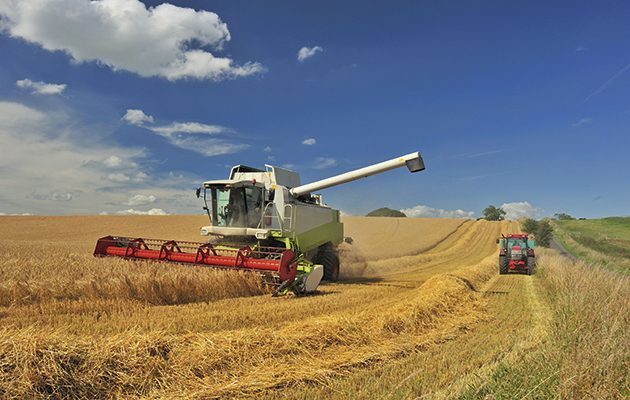In the first of his regular columns on modern farming, Tim Field of Agricology considers how shifts in cereal production could offer wider benefits
In the first of a new regular column for The Field on modern farming, Tim Field considers the UK harvest and current shifts in cereal production.
If your homegrown harvest consists of apples rather than barley and wheat, read the 9 best apple recipes for your harvest to avoid an endless stream of crumbles and pies.
HARVEST IN THE UK
The familiar drone of a combine, grain trailers tearing down the country lanes, pigeon and partridges pitching into the stubbles scouting for spoils – another growing year reaches its climax. In 2015, the UK harvested 16 million tonnes of wheat and seven million tonnes of barley, and supplied it to some increasingly interesting markets.
In terms of milling wheat, entering into contract and supplying food companies is nothing new. However, the relationship seems to be changing. We are ever hopeful that the consumer is willing to value the farmers’ custodianship of our land, knowing that if we neglect our soils, water and wider ecology now the cost of production will hit us in the future. There are signs the message is getting through. A proportion of the 100,000 tonnes of English wheat that go into Kellogg’s All Bran, Special K and Bran Flakes at its Wrexham factory is taken from the
GWCT Allerton Project in Leicestershire. The Project meets with others in the Kellogg’s supply group for exchanges on management practices, such as weed control and soil ecology, while sharing farm environmental improvements. Similarly, Jordans recently announced collaboration with LEAF and the Wildlife Trusts.
Although much of the harvest goes to the big players, there remain a number of smaller mills – such as Shipton Mill and Doves Farm Organic – that have great agility in the supply chain. They process a diversity of grain types for different markets. Lead by a resurgence of artisan bakers, the slower proving times and sour-dough breads are less dependent on high-protein wheat varieties. The strength of this market is not only down to the rise in gastronomy but also due to gluten intolerance among our population and suspicion surrounding agri-chemicals, most recently glyphosate, demanding a rethink in agricultural systems. These markets, the artisan bakeries and ability of smaller mills to handle farm-scale batches is also in part responsible for the renaissance of ancient grains, such as spelt, that have lower gluten levels and can grow well in a low-input system. There is also an increasing presence of pulses and seeds, from quinoa to marrowfat peas, occupying the shop shelves.
HARVEST CROP FOR ANIMAL MOUTHS AND NEW MARKETS
Of the seven million tonnes of barley harvested in the UK annually, about two million is destined for malting; divided roughly equally on either side of Hadrian’s Wall. But if a cereal harvest fails to meet the high specifications required for this, the UK has no shortage of animal mouths to feed and, under the right circumstances, cereals provide a good source of energy and protein. Indeed, the crop may always be destined for feed, as is commonly the case with triticale. A rye-wheat hybrid that is more tolerant to weed burden and fertility-depleted soils, triticale is a handy weapon as a second cereal in an organic rotation. However, if a mixed farm system has a silage pit that needs filling or a crop full of weeds, some crops are ensiled and included in winter rations.
Another flourishing market is energy crops. Although biofuels only comprise a couple of percent of the UK’s total harvest, it is a growing proportion and a fifth of all maize grown is now ending up in anaerobic digesters. The impact this is having on our soils and rivers is up for debate.
Not all grains and seeds are waved goodbye to be milled, malted and digested. If stored correctly, a robust piece of machinery on the back of an articulated lorry can roll into the yard, load grain at one end, clean, and spit out graded seed at the other end – ready for drilling again. The ancient practice of seed hoarding still exists, albeit restricted by plant breeders’ rights and hybrids that enable new variety development and improved performance. Daylesford Organic Farm’s manager, Richard Smith, has successfully taken seed from the sainfoin and white clover and is looking at saving up to £140 an acre on seed costs. Furthermore, the Organic Research Centre has been exploring the principles of genetic diversity and natural selection to create a resilient, productive, low-input wheat population suited to the specific environment from which it has been harvested and resown.
As songbirds and partridge become more evident in the stubbles, there is a dawning of new markets, politics and economics prompting a shift in agriculture. Past policy, farming and competing land management objectives have us sectioning off field margins and corners for our quinoa, triticale, sunflowers, sorghum and legumes to arrest the decline of farmland bird populations. However, may there be an increasing attraction towards those crops occupying the entire field? Not land sparing but land sharing for successful farm business, conservation and sporting interests.
Follow Tim and Agricology on Instagram: @agricology





